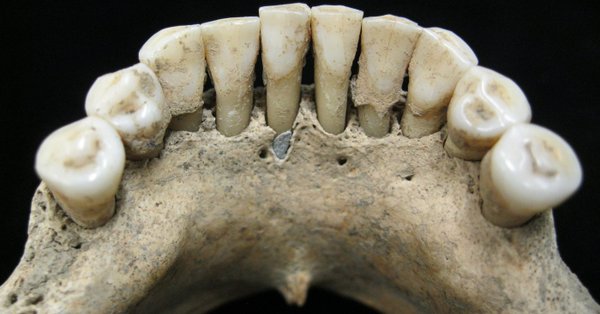A team of researchers and archaeologists have found evidence that suggests women were more frequently involved in the laborious task of manuscript production in the Middle Ages than was previously believed. The study utilized new technology to examine the dental plaque on the nearly 1,000-year-old remains of a nun.
When co-author Anita Radini took a closer look at the tartar built up on the teeth of the remains, exhumed from a women’s monastery in Dalheim, Germany, she noticed brilliant blue specks embedded throughout. She identified the particles of blue pigment to be lapis lazuli, a semi-precious stone that was the primary source of blue in medieval paintings.
NPR reported:
Tiny bits of blue pigment in a medieval female skeleton were a big discovery for scientists, suggesting that women — not just monks — worked on making lavishly illustrated texts. https://t.co/pZdOdw4SJT
— NPR (@NPR) January 10, 2019
While it is common practice today to brush our teeth regularly, 1,000 years ago plaque and tartar were often left to build up and mineralize over the course of a lifetime. The remains of people from so long ago will have fossilized plaque that still contains particles that tell us of their diets, living conditions, and even their professions. Some of the particles that have been identified through this process include tree and grass pollen, spores, cotton and bast fibers, medicinal plants, as well as diatoms, sponge spicules and micro-charcoal.
The presence of lapis lazuli on this nun’s teeth tells us several things about her history. She was most likely a woman of note with money, or a member of a community endowed with wealth, as lapis was only mined from Afghanistan in the Middle Ages and was worth its weight in gold by the time it reached Europe along the Silk Road.
A number of suggestions have been made as to how the lapis found its way onto her teeth, from painting to accidental ingestion during pigment preparation, or even the consumption of the powder as a medicine. The latter explanation seems doubtful, however, as there were over 100 blue particles found, suggesting repeated exposure rather than a one-time ingestion.
It also does not seem likely that she was the one who prepared the pigment, as the process was intricate and not practiced in Europe until several hundred years later. The lapis lazuli pigment was probably shipped to Europe as a finished product, leaving us with just the theory that she was indeed using the lapis for her artistic endeavors. The particles could have made their way onto her plaque when she licked the paint brushes to a point, a medieval practice that has been well documented.
The finding suggests that women were more involved with the production of books in the Middle Ages than previously thought. Less than 1% of books produced before the 12th century can be reliably traced back to women — not surprising when we remember that works of art were rarely signed prior to the 15th century, and illuminated manuscripts seldom signed at all.
Researcher and co-author of the study Christina Warinner from the Max Planck Institute for the Science of Human History is hopeful that this new technology will help to identify more women artists who were lost to history:
“We have this view there was only a handful of extraordinary women in the past that seemed to be different from everyone else but I think that more were involved than we give credit for. Here we have direct evidence of a woman, not just painting, but painting with a very rare and expensive pigment,” she said. “This woman’s story could have remained hidden forever without the use of these techniques. It makes me wonder how many other artists we might find in medieval cemeteries — if we only look.”

